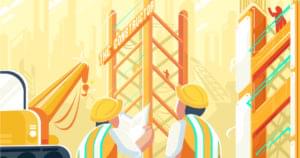 If you’re a creative, your folio could mean the difference between your winning or missing out on a job.
Folios represent your work; like a product sample, your folio makes a clear statement about your skills. It also says something about the kinds of work that interest you, the clients who put their trust in you, your creative process, and how committed you are to quality output.
There are a few golden rules you should follow as you put together a folio of your work. These are the ones I try to stick to in compiling my folio.
1. Choosing the work
In choosing which pieces to put into your folio, consider the job and the work it entails, then match the folio pieces you have to the job requirements.
If you’re compiling an online folio for your business, you may not have a specific job in mind. That’s fine; identify the types of work you want to do and choose pieces that reflect your experience with that kind of work. If you’re trying to move into a new area, try to choose folio pieces that indicate that you have the skills to work in that area, even if you haven’t yet.
In selecting pieces, make sure:
If you’re a creative, your folio could mean the difference between your winning or missing out on a job.
Folios represent your work; like a product sample, your folio makes a clear statement about your skills. It also says something about the kinds of work that interest you, the clients who put their trust in you, your creative process, and how committed you are to quality output.
There are a few golden rules you should follow as you put together a folio of your work. These are the ones I try to stick to in compiling my folio.
1. Choosing the work
In choosing which pieces to put into your folio, consider the job and the work it entails, then match the folio pieces you have to the job requirements.
If you’re compiling an online folio for your business, you may not have a specific job in mind. That’s fine; identify the types of work you want to do and choose pieces that reflect your experience with that kind of work. If you’re trying to move into a new area, try to choose folio pieces that indicate that you have the skills to work in that area, even if you haven’t yet.
In selecting pieces, make sure:
- you’ve included a range of executions (for example, if the project is designing a membership-based web service, you might include a range of examples of membership-based sites you’ve designed)
- you can explain the creative process and rationale for each piece you’ve included
- you’re proud of every piece in the context of the current creative and technical environment
Frequently Asked Questions (FAQs) about Preparing a Job-Winning Folio
What is the importance of a job-winning folio?
A job-winning folio is a crucial tool in showcasing your skills, experiences, and achievements to potential employers. It provides a tangible proof of your abilities and can set you apart from other candidates. It’s not just about listing your qualifications, but also about demonstrating how you’ve applied them in real-world situations. A well-prepared folio can make a significant difference in your job search, helping you to stand out and impress potential employers.
How can I tailor my folio to specific job applications?
Tailoring your folio to specific job applications involves highlighting the skills and experiences that are most relevant to the job you’re applying for. Start by thoroughly reading the job description to understand what the employer is looking for. Then, select and present your work samples that best demonstrate these skills or experiences. Remember, quality trumps quantity. It’s better to have a few highly relevant pieces than a large number of unrelated ones.
What should I include in my folio?
Your folio should include a variety of work samples that demonstrate your skills and experiences. This could include projects you’ve completed, designs you’ve created, articles you’ve written, or any other tangible evidence of your work. Additionally, you should include a resume, a cover letter, and any relevant certifications or awards. It’s also a good idea to include testimonials or references from past employers or clients.
How should I present my folio?
Presentation is key when it comes to your folio. It should be organized, professional, and easy to navigate. Consider using dividers or tabs to separate different sections. Make sure your work samples are clearly labeled and include a brief description of each piece, explaining what it is, when and why you created it, and what skills or experiences it demonstrates.
Can I include digital work in my folio?
Absolutely! In today’s digital age, including digital work in your folio is not only acceptable, but often expected. This could include website designs, digital marketing campaigns, social media strategies, or any other digital projects you’ve worked on. Just make sure to provide a way for potential employers to access and view these pieces, such as a URL or QR code.
How often should I update my folio?
It’s important to keep your folio up-to-date, adding new work samples and removing outdated ones. This shows potential employers that you’re continually learning and improving your skills. As a general rule, you should review and update your folio at least once a year, or whenever you complete a significant project.
How can I make my folio stand out?
Making your folio stand out involves showcasing your unique skills and experiences, as well as your creativity and professionalism. This could involve using a unique design or layout, including a personal branding statement, or incorporating multimedia elements such as videos or interactive content. Remember, your folio is a reflection of you as a professional, so make sure it represents you well.
What mistakes should I avoid when preparing my folio?
Common mistakes to avoid when preparing your folio include including too many or irrelevant work samples, poor organization, lack of descriptions for your work samples, and not tailoring your folio to the job you’re applying for. Additionally, make sure to proofread your folio carefully to avoid any spelling or grammar errors.
Can I use a digital platform to create and present my folio?
Yes, using a digital platform to create and present your folio can be a great option, especially for jobs in the digital or creative fields. There are many online platforms available that allow you to easily upload and organize your work samples, and share your folio with potential employers. Just make sure to choose a platform that is professional and easy to use.
How can I get feedback on my folio?
Getting feedback on your folio can be incredibly helpful in improving it. Consider asking mentors, colleagues, or professionals in your field to review your folio and provide feedback. You could also seek feedback from career counselors or professional development workshops. Remember, constructive criticism is a valuable tool for growth and improvement.
Georgina has more than fifteen years' experience writing and editing for web, print and voice. With a background in marketing and a passion for words, the time Georgina spent with companies like Sausage Software and sitepoint.com cemented her lasting interest in the media, persuasion, and communications culture.



